Customer Data Platform
The complete guide to customer data platforms including features, use cases, and comparison with other data platforms
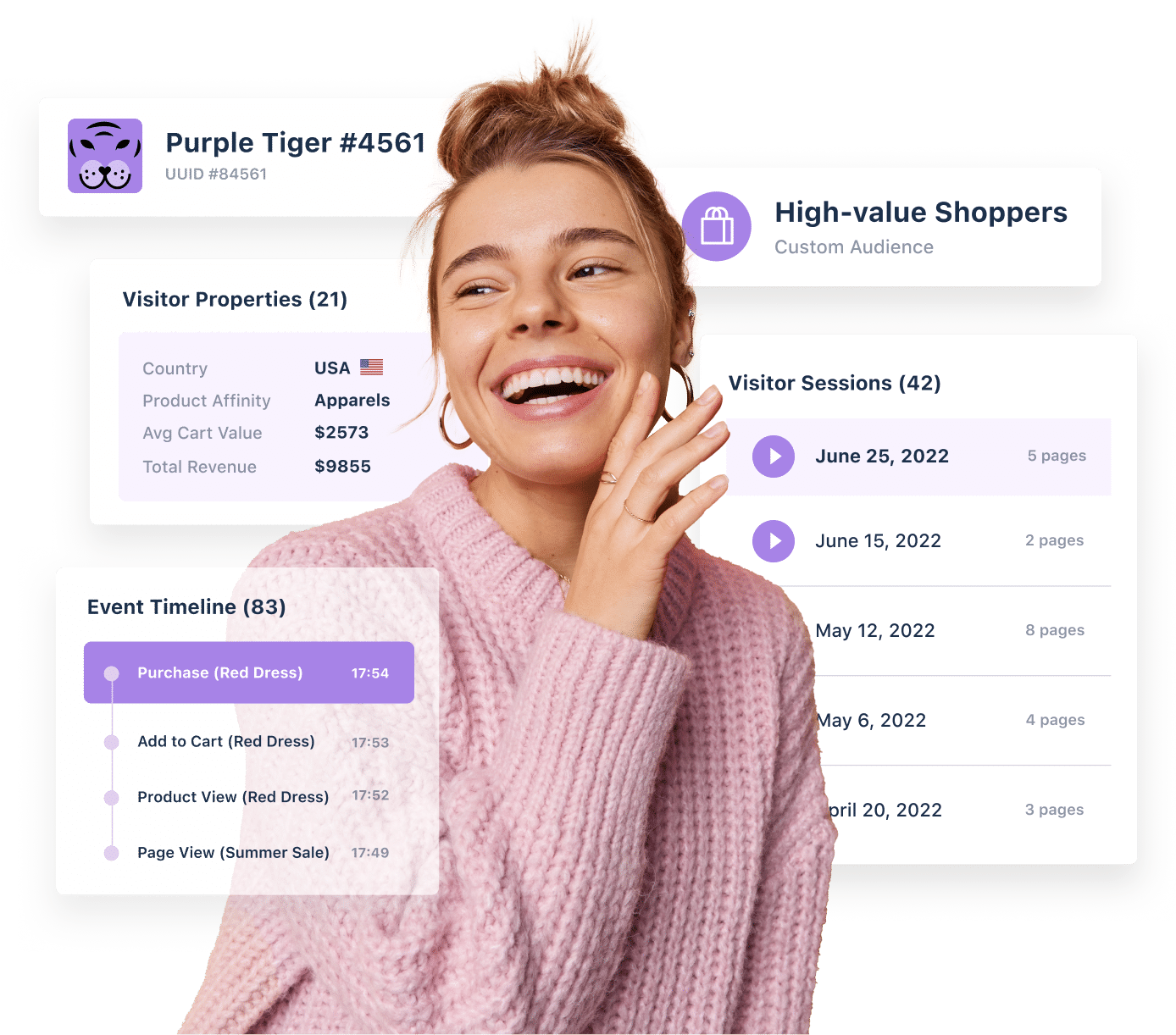
Organizations, in general, have traditionally not done a good job of being guardians of their data. Their data lies scattered, unassigned for follow-up, unpicked for further engagement, unattended, unmapped, and unclean across multiple teams and systems, in silos. Eventually, it piles up making the data unusable. Their data exists in numerous places, not annotated, unstructured with no taxonomy around it leaving a huge void. A CDP fills this gap by refining data, mapping, and integrating data in a panoramic view. It is about time they value their data.
Factor this. Norman is a marketer in an eCommerce company. He wants to run an experimentation campaign targeted at his customers who have bought a MacBook in the past. Using audience segments in a CDP he can easily collect the customer data of past MacBook buyers and target his campaign to the cohort.
Imagine the customer interactions with your web pages as pieces of a puzzle scattered across a room. A CDP collects all these fragmented pieces (data) from different corners (read web pages!) of the room and gathers and connects them coherently.
What is a customer data platform?
Customer Data Platform or CDP is the nucleus where all your customer data rests in a connected and integrated fashion as unique customer profiles. A CDP adds value, form, identity, and meaning to otherwise fragmented data. It includes offline, online, structured, unstructured, and semi-structured data clubbed into a logical sequence. It depicts the behavior, interactions, and buying journey of your customers. In other words, a customer data platform collects all your customer data in real-time from various sources to create unified customer profiles. This kind of integrated single view of a customer profile enables you to run personalized marketing campaigns, select the best prospects, estimate churn, and the future value of a customer among other use cases.
CDPs have evolved over the past few years to become a primary component of the Martech stack. They provide a complete picture of every visitor’s true intent, behavior, and interests. It enables organizations to deliver personalized customer experiences. If personalization is the engine that drives modern marketing, CDP is the fuel. After all, data is the modern-day fuel!
This in-depth guide on CDP will help you understand the need and importance of customer data platforms, discuss connected marketing and how CDPs can help with your ABM strategy, differentiate CDP from other data platforms, evaluate the right CDP for your needs with the help of a ready-to-use checklist, and provide a deeper analysis into the top use cases of CDP.
Why is the Customer Data Platform important?
Companies generally find themselves in either of the two extremes – neglecting customer data, or delving into it and trying to make sense of it. Using a CDP you can collect and consolidate customer data including demographics, buying behavior, and product affinities. This helps solve the following problems-
Integrating fragmented and unstructured customer data
CDP collects all your real-time data from various sources using native integrations and APIs. You can upload customer data as custom lists, like offline POS data, purchase data, loyalty card info, surveys, etc.
Maintaining data quality and integrity
It is challenging to maintain the integrity of your customer data between multiple platforms. For example, VWO’s Data360 helps bridge data gaps, eliminate data duplication, and reduce data discrepancies, among other things.
Continuous and updated ingestion of customer data
CDP provides a comprehensive and up-to-date view of a customer and the signals that determine their intent. Without this, your data view is outdated and does not give you the right picture resulting in delayed decisions based on customer data.
Staying on top of data regulations
Ensuring data compliance when managing customer data can be difficult. CDP solves this problem with an in-built privacy infrastructure design that ensures you get greater control over PII formats like email, phone number, etc. It gives you the flexibility to take decisions like who gets access to PII, whether it should be removed from profiles, etc. You can further filter and secure the data by adding certain patterns and rules specific to your business.
Eliminating data silos
Your campaigns need accessible and ready-to-action data, which is often challenging. A CDP can either be used to centralize customer data or with data export capability you can seamlessly and securely export clean data, rule-based segments, and highly enriched customer profiles to your analytics, marketing, or sales support platform.

Why do companies use CDP?
Scattered data is a nightmare for any marketer. What to pick, where to find, how to correlate, which ones to connect, what to base the messaging on, and other questions about the data lying in silos are stared at indifferently. A CDP eliminates all such uncertainties by unifying customer data and empowering teams to look at data more confidently and at ease. Let’s take a look at the broader reasons and underlying value of using a CDP.
Connected Marketing
Customers don’t want marketing that goes to everybody out there. Nobody likes to be seen as run-of-the-mill. They would rather prefer to be spoken to as individuals and addressed with relevant messages specific to them. Connected ecosystems simplify your tasks and make it easy to extract data quickly. CDPs are robust, unified, and customizable repositories of individual customer profiles. It helps you extract customer journeys that enable you to create personalized messaging around them.
Mapping customer journeys
CDP connects the touchpoints and maps the journey of each customer to understand their behavior and what they are looking for. This gives you deeper insights into demographics, product affinities, and buying behavior making every bit of granular customer data more meaningful, actionable, and ready to use.
CDP depicts each visitor’s journey through your web page, social media, blog, and resources, filling up a form, coming back after a few days to download a white paper, and then being inactive for a few weeks to finally come back to check the prices or ask for a quote/call a representative. The visual representation of all this data is akin to storytelling. So you have the individual visitor journeys that tell the story of their interaction with your touchpoints which, in turn, helps you craft tailor-made messaging for each of these individuals – now isn’t this the foundation of Account Based Marketing?
Strengthening ABM strategy
Account-based marketing (ABM) is a one-on-one communication strategy used in B2B marketing. It involves communicating with the key decision-makers of an organization by sending them highly personalized messages based on their stage in the sales funnel. ABM helps in building lasting relationships with clients.
It involves understanding customer behavior and analytics across the web pages for creating personalized messages.
A CDP gathers customer interactions on multiple touchpoints lying fragmented in different systems bringing them together to provide a holistic view of the buyer journey. These are not only accessible but also actionable and powerful insights that enable faster deployment of marketing campaigns. You can create customer engagement strategies, modify touchpoints, add relevant CTAs to the page based on behavioral insights, and create an ecosystem conducive to optimizing conversions on your website.
You can create strategic personalization campaigns leveraging your customer data by strategizing personalization campaigns based on the actionable insights that a CDP provides.
It also enables you to target your customers with contextual experiences based on their affinities and behavior to nudge them ahead in their buying journey.
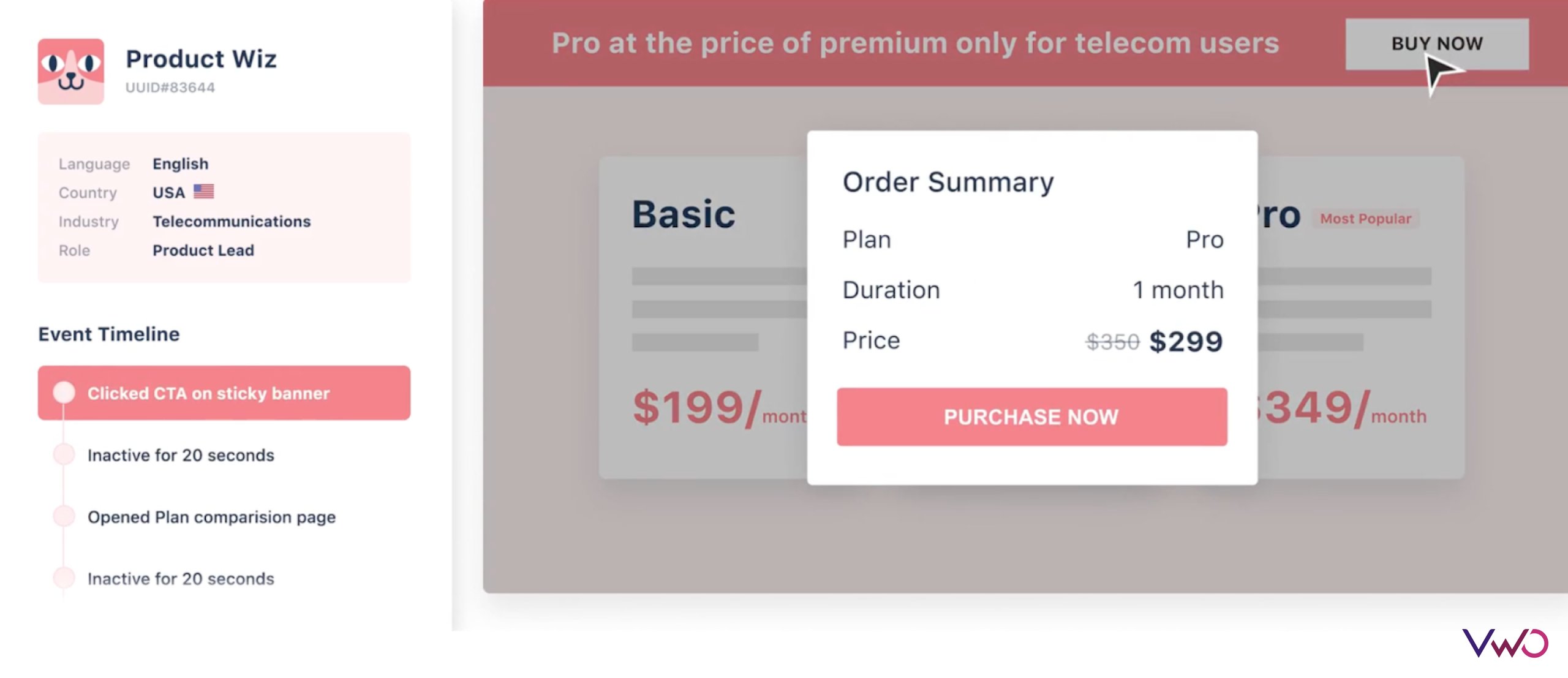
What makes CDP different from other data platforms?
In common parlance, most of us tend to find a lot of commonalities among the various data platforms that are available today. However, there are a few subtle, specific as well as prominent differences between each of them. Let’s take a look at how they can be told apart from a CDP.
What is the difference between CDP and Marketing Automation?
The core use cases and functionalities for both CDP and marketing automation are different. While CDP gathers data from multiple sources and systems to provide a single view of a customer’s buying journey, marketing automation enables you to send automated messages through text, email, social, and the web. Using CDP, businesses deliver personalized experiences and enhance support and delivery to their customers. Marketing automation on the other hand helps businesses increase efficiency while eliminating repetitive tasks from their workflow.
What is the difference between CDP and CRM?
CRM is used by customer-facing teams to help them manage customer relationships. It provides data such as customer names, support ticket files, interactions with the sales team, etc. A CDP on the other hand provides data on customer interactions and engagement with digital touchpoints, right from the channel they found you to how they behave on your website and product page.
How are DMP and CDP different?
CDP and DMP vary in the type of data that they gather. While DMP collects third-party data including customer IDs and cookies, CDP collects personally identifiable information of first-party data that could be structured, unstructured, or semi-structured. DMP stores data for a short time, whereas CDP stores data for a longer period. CDP enables marketers to build customer profiles with deeper insights into their buying journey.
What is the difference between CDP and Data Warehouse?
Data warehouses are huge, high-involvement, and IT-dependent platforms of corporate data that are enterprise repositories for analysis. As compared to a Data Warehouse, a CDP is much smaller in scale and pertains to customer data used primarily by marketers. A Data Warehouse is used mainly for business reporting and analysis and does not support real-time updates, unlike a CDP. A Data Warehouse also does not transform or normalize data for marketing initiatives. For example, a Data Warehouse will store online transaction data as a code, say, LT3264, and not as a ‘green nylon bag’. A CDP transforms this code into text that is meaningful for marketing and personalization campaigns.
What is the difference between CDP and Data Lake?
A Data Lake is used for storing unprocessed, raw data in its original form and without transforming or normalizing it in any way. A Data Lake is beneficial for AI and ML-based systems and is commonly used by data scientists to test AI-based algorithms. A CDP on the other hand stores first-party customer data transforming and normalizing the data into meaningful, deeper, and actionable customer insights to help marketing teams run tailor-made campaigns.
What is the difference between CDP and Master Data Management?
Master Data Management refers to the creation, maintenance, and management of critical enterprise data including tools, technologies, and processes that form the core of enterprise operations. MDM is mainly used by data governance users, administrators, and data stewards from various departments who are the custodians of data. It is also used by project managers, program managers, systems administrators, IT project leads, database administrators, and other stakeholders to drive quality and business results. A CDP on the other hand focuses on aligning systems and destinations while improving the marketing function.
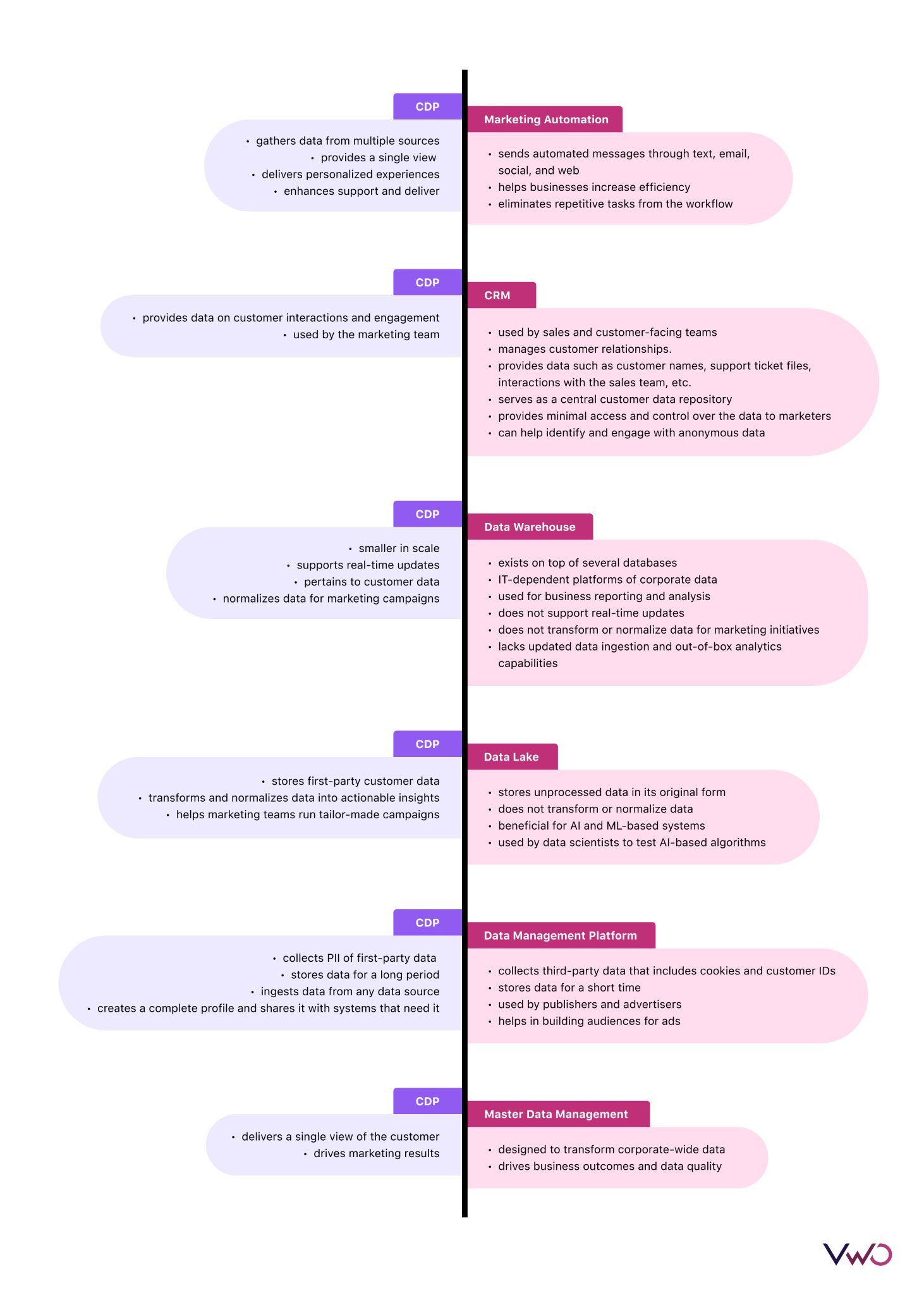
Companies that do not use any data platform depends upon their in-house development team for data processing. This takes weeks or even months to respond to a customer.
Most businesses, based on their business need can choose to have a CRM, Data Warehouse, CDP, Marketing Automation, or any combination of platforms. The decision largely depends upon the purpose, context, how the technology is integrated, and where the data is centralized for reporting as well as marketing.
Features of a CDP
Here’s a quick checklist of the features of a CDP to help you make an informed decision on the right CDP.
- Collects, aggregates, and enriches your customer data in real-time.
- An inherent data-gathering source with events, properties, and behavioral data of website visitors.
- Collects visitor/user/customer data and uncovers actionable insights from the collected data at speed and scale.
- Gathers and centralizes customer data including demographics, product affinities, and buying behavior.
- Makes every bit of granular customer data much more meaningful, accessible, actionable, and ready to use.
- Houses advanced visitor behavioral insights data in the form of session replays, form analysis, survey responses, heatmap clicks on a website, etc.
- Aggregates standard Goals/KPIs like form submissions, page visits, or clicks on elements.
- Defines and tracks complex business metrics like lifetime value per user and average order value per user, north star metric, etc. using raw customer data.
- Enables the creation of metrics from CDP data for use in campaigns.
- Works hand-in-hand with experimentation and personalization modules to meet conversion and revenue goals.
- Provides a complete, integrated/connected platform to help track and achieve goals.
- Cleans the data by eliminating redundant data points and merging duplicate data in different formats as one.
- Computes new customer properties like age, lifetime value, or any custom data on top of the raw data pool.
- Ensures data quality and governance across all channels.
- Optimizes experiments helps personalize buying journeys and fine-tunes marketing campaigns.
From a list of vendors, how will you compare and choose the right CDP? You can ask the following questions:
- Does the data sync in real time or after a few hours?
- How easy is it to connect data sources?
- What’s the value added on top of the data layer?
What is VWO Data360?
If there exists a CDP in the market that ticks all boxes in the above checklist, it is VWO’s customer data platform, VWO Data360. VWO Data360 is your complete, single, and coherent view of all your customer data – attributes, events, uploaded data, and third-party data.
Attributes in VWO are the variables whose values help you identify and segment visitors. Some of the common attributes include the traffic source of the visitor, the browsers used by visitors to land on your webpage, the visitor’s location, etc.
Using attributes, you can track the visitor data that is critical to your business, such as visitors’ gender, subscription level, etc. For example, if you are a SaaS company, you may want to categorize users based on their subscription plans, or a travel agency that recently ran promotional offers may want to view conversions by age group.
Events in VWO refer to actions performed by a visitor on the website. This can be a click on an offer banner, making a payment, scrolling down the page, etc. Each event has a name and a set of properties that describe it. An event called “Transaction” may have attributes like “transaction ID” and “amount”.
An event can be used as an indicator to track any visitor action that is crucial to your business, such as “conversions”, “cart abandonment”, etc. This can then be used to target visitors for your VWO campaigns.
VWO Data360 allows you to collect and enrich data from any source – out-of-the-box, third-party integrations, uploaded data such as your customers’ browser data, and data imported through native integrations with CMS, ABM platforms, or via APIs. With a single interface, it gives you access to all the critical customer datasets such as behavioral data, experimentation data, visitor actions, and browser data you need to make smarter decisions to build delightful experiences.
Use cases of a CDP
With the help of a robust CDP, companies can accelerate their optimization program by 10x. Let us take a quick look at the most common use cases of the platform.
Data collection and connecting data
You can collect and centralize all customer data enabling any type of first-party data to be aggregated whether it is online, offline, structured, unstructured, or semi-structured. Using a CDP, you can collect data from multiple sources via connectors, and ingest and aggregate data in real-time in a hub.
The data collected can include your customers’ location, device, language, sessions, operating system, actions on your website, survey responses, session recordings, form analytics, heatmaps, and any experimentation data that you may have.
The sources you collect these data could be your customers’ browsers, third-party platforms, or offline data sources. Data from your customers’ browsers could be their device, country, operating system, traffic source, etc., and their activity on your website which gets automatically populated directly from the customers’ browser on any device. Third-party data may include data from CMS or ABM platforms or CDP. Offline data could be POS data, loyalty card info, surveys, purchase data, etc.
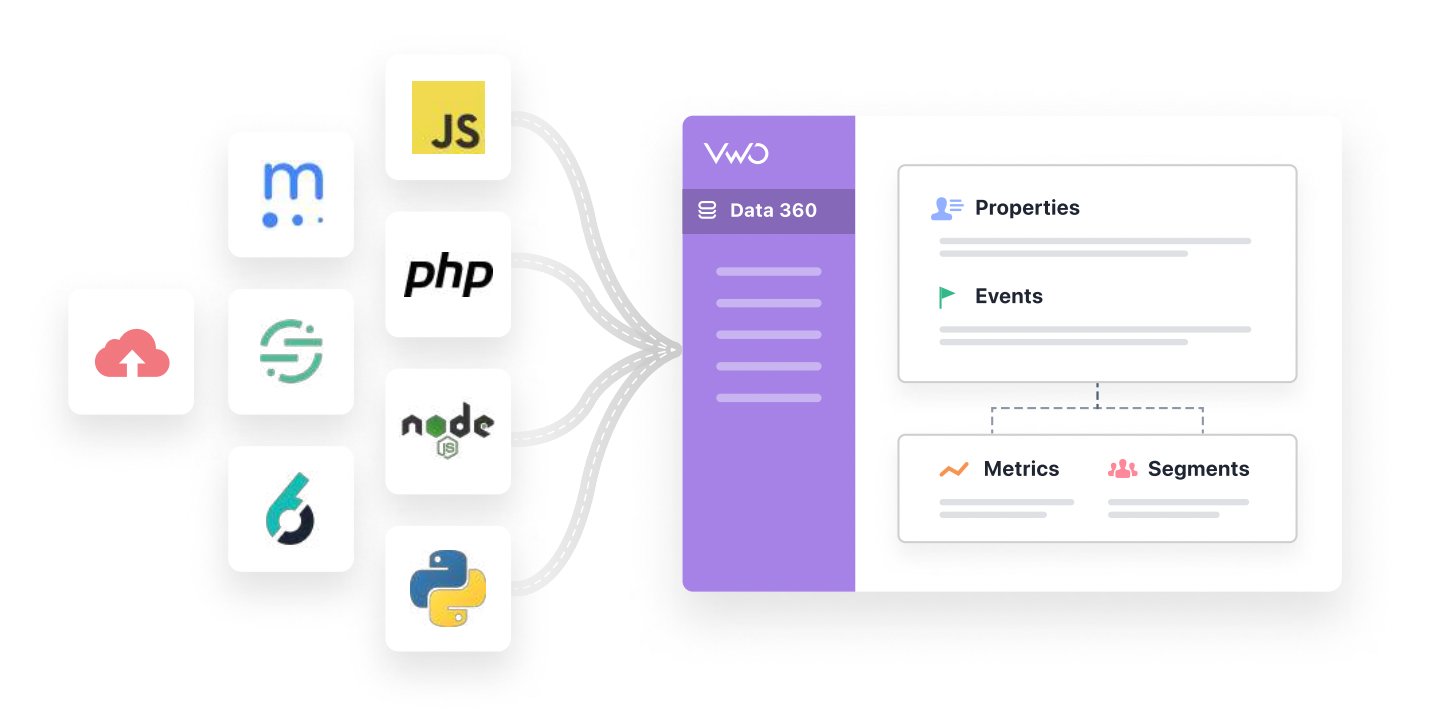
Data enrichment
VWO Data360 allows you to capture data from all possible sources but also refines it with the removal of duplicate values and ML-driven data enrichment. All that data is ready to be used to sharpen customer experiences from a single, easy-to-use platform.
Data unification
VWO Data360 acts as a hub for all customer data captured from different sources in multiple formats. For example, the data captured from your customer’s browser includes information on their location, language, device, operating system, sessions, etc.
It centralizes these diverse datasets and unifies them in a consolidated view. It records every activity or engagement your customer makes on your website in the form of chronological events. VWO Insights tracks your customers with analytics tools like heatmaps, form analytics, session recordings, etc.
VWO Testing captures data around how your customers are responding to your experiments and whether or not they are converting for metrics that matter.
Segmentation and targeting
A CDP segments customers before unifying first-party and third-party data from multiple sources and systems to build a single, coherent, and complete view of each customer. With various customer data permutations and combinations including age, gender, traffic sources, pages per session, and clicks, you can create a variety of micro-segments that can be used in your campaigns with VWO Data360. For example, customers from California who have bought an Apple product with a cart value of more than $4000. It helps you further refine segments with in-depth third-party data. It also enables you to export these segments to use in other marketing, CRM, and engagement platforms.

Single view
VWO Data360 integrates all your customer data in one view. As a result, you can see customer segments, actions, profiles, properties, and their behavior across multiple campaigns. This helps you connect the dots by unifying all your customer data in one place. The result is actionable customer profiles that summarize visitor properties, actions, segments they are part of, and their evolving behavior in various campaigns across multiple touchpoints.
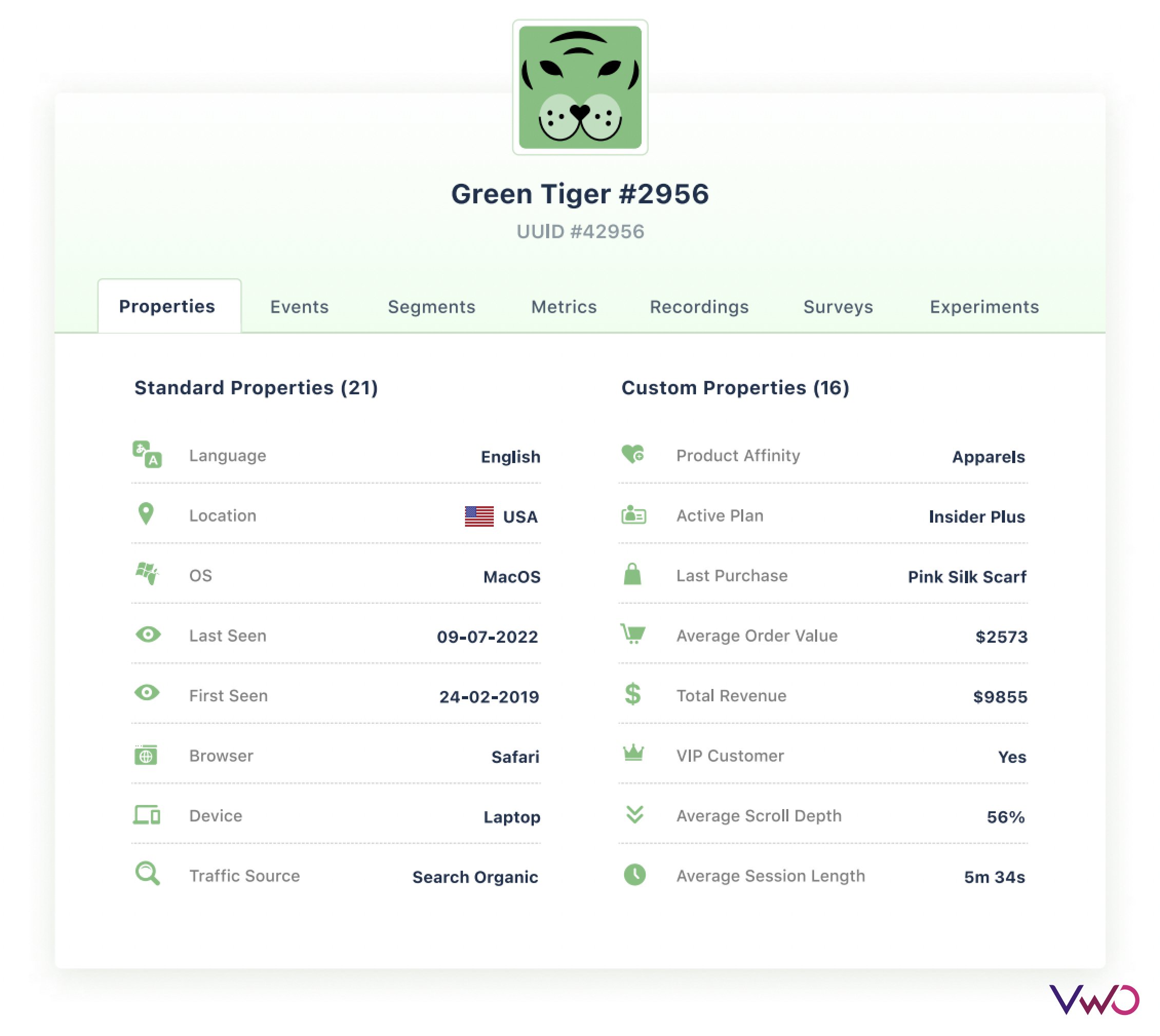
Why do enterprises choose VWO Data360 over other CDPs?
Here are a few reasons why enterprises rely on VWO Data360 for their needs:
- As a platform, VWO is a data-generating source by itself. This means that all the properties, events, and behavioral data of website visitors reside in VWO, which other CDPs do not offer.
- VWO platform also houses advanced visitor behavioral insights data in the form of session replays, form analysis, survey responses, heatmap clicks on a website, etc. This helps collect behavioral data of website visitors which helps build their profile.
- The unique metrics module of VWO Data360 enables the creation of custom metrics using website visitor data like form submissions, page visits, or clicks on elements.
- VWO Data360 aggregates customer data to make complex business metrics like lifetime value per user and average order value per user, north star metric, etc. using raw customer data. These metrics can be created from CDP data and used in marketing campaigns.
- VWO’s experimentation and personalization modules tightly integrate with VWO Data360 to enable customers to reach their conversion and revenue goals.
- It provides a complete, integrated/connected platform to help enterprises track and achieve their business outcomes faster.
- Enables businesses to compute new customer properties like age, lifetime value, or any custom data on top of the raw data pool.
How can you leverage customer data with VWO Data360?
More often than not, organizations fail to utilize their customer data pool to the best of their advantage. Let’s take a look at how VWO Data360 can be used by businesses in different industries for leveraging their customer data.
VWO Data360 for SaaS
- Your sales execs can enjoy agent access to the complete history of customer activity before their interactions with potential customers for a sales call or demo.
- Know when your customers check their mailboxes and send emails or other outbound messages at optimal times for each customer.
- From the existing leads, you can select the best prospects using a lead-scoring model based on CDP data. This will also happen on marketing automation tools using CDP data outside of CDP.
- You can calculate the likelihood of customer churn using the data available in VWO Data360. This can be done using events and metrics, creating certain events that count toward a churn activity.
- You can also calculate the future value of a customer based on CDP data. This can be done using events and metrics, creating certain events that count toward an increase or decrease in value.
VWO Data360 for travel
- Deliver real-time location-based personalization by displaying tailored messages in real-time based on current customer location and historic data from CDP.
- You can highlight specific amenities of the properties in the area based on the past purchase preferences of the customer as per their CDP profile.
- Offers for non-room-related services, such as restaurant or casino credits can be enabled by hotels based on a person’s spending behavior.
- You can select loyalty incentives using a model based on CDP data.
VWO Data360 for eCommerce and retail
- Target your experimentation campaign to a set of people who have completed a certain set of actions in the past. For example, customers from Germany who have bought a washing machine in the past two months.
- Analyze a customer’s purchase history and target them on the website in real-time. This can be done via an integrated tech stack.
- Calculate total revenue across all purchases done by a customer.
- Re-target users that add items to their cart and abandon it. This can be done using metrics, events, and integrations. You can track who’s adding products to the cart and not checking out within a specific period and retarget them using personalized emails/push notifications/ads, etc reminding them to complete the transaction.
VWO Data360 for others
- Update the targeted lists just before channel execution to remove customers who have recently taken an action that is communicated. This can be done using events.
- Organizations need the ability to produce automated lists of known individuals with real-time data for real-time execution and eliminate batch processing. This can be done using events and metrics.
- Collect customer insights and provide those back to its product teams to improve the product.
Customer data and privacy
At the core of VWO is its privacy-first approach that helps us adhere to global data protection standards and regulations. VWO Data360 is built on a secure architecture with airtight privacy and security controls to protect your visitors’ data.
VWO’s enterprise-grade data encryption ensures that all unique user IDs stored in our database are one-way hashed at the client’s end. All PII formats are scanned for and removed from the profiles automatically. You can filter and secure the data further by adding your own patterns and rules such as email, phone number, or any other personally identifiable information of visitors.
VWO Data360 hosts all your data on the Google Cloud Platform and is distributed across data centers in different locations across the globe. Apart from standard certifications, VWO is also compliant with global regulatory acts like GDPR, CCPA, and HIPAA.
Conclusion
By now, you would have got more clarity and an in-depth understanding of customer data platforms, why businesses need CDP, how it is different from other data platforms, various industry-specific use-cases of CDP, and the value that businesses derive out of VWO Data360.
At VWO, we believe in creating products that deliver the best experiences for our customers. VWO Data360 is the tool every marketer deserves to help them create personalized experiences for their customers that delight and convert.
For more information on VWO Data360, request a demo.











